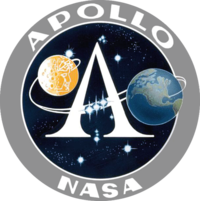AS-102
| Mission Insignia | |
|---|---|

| |
| Mission Statistics | |
| Mission Name: | A-102 (Saturn-Apollo 7) |
| Call Sign: | A-102 (SA-7) |
| Launch: | September 18, 1964 16:22:43 UTC Cape Canaveral Complex 37B |
| Reentry: | September 22, 1964 ~07:20:00 UTC |
| Duration: | ~3 days 15 h |
| Number of Orbits: |
59 |
| Apogee: | 126 mi (203 km) |
| Perigee: | 111 mi (178 km) |
| Period: | 88.4 min |
| Inclination | 31.7 deg |
| Distance Traveled: |
~1,483,099 mi (2,386,816 km) |
| Apogee Mass: | 16,700 kg |
| A-102 (SA-7) | |
A-102, or SA-7[1] was the second Saturn rocket launch to carry a boilerplate Apollo spacecraft.
Objectives
A-102 was designed to repeat the flight of A-101. It would once again carry a boilerplate Apollo Command and Service Module. The only difference from Boilerplate 13 carried on A-101 was that on Boilerplate 15 one of the simulated Reaction Control System thruster quads (attitude control thrusters) was instrumented to record launch temperatures and vibrations. Another major difference on A-102 was that the Launch Escape System (LES) tower would be jettisoned using the launch escape and pitch control motors. The mission used Apollo boilerplate BP-15.

However, the major change on A-102 was that for the first time a Saturn rocket would carry a programmable computer. Previous launches had used an onboard 'black box' that was preprogrammed. On A-102 it would be possible to reprogram the computer during flight so that any anomalous behavior could potentially be corrected.
Flight
In early July, a small crack in engine number six was found. This meant removing the engine, the first time that the ground crew had to do this with a Saturn rocket. It was then decided to return all eight engines to the manufacturer, which meant a job that took about ten hours because the large number of tubes, hoses and wires that connected each engine to the rocket. The replacement delayed the launch by about a fortnight, followed by another delay of several days because of Hurricanes Cleo and Dora.
Launch was on 18 September just before noon local time. The first stage burnt for 147.7 seconds, with separation 0.8 seconds later. The second stage ignited 1.7 seconds later, and the LES jettisoned at 160.2 seconds after launch. It burned until +621.1 seconds with the stage and boilerplate in a 212.66 by 226.50 km orbit.
The flight met all its objectives. The spacecraft continued to transmit telemetry for five orbits and was tracked right up until re-entry on its 59th orbit over the Indian Ocean.
The only anomalous event on the flight was the failure to recover the eight film-camera pods. They had landed downrange of the expected area, where Hurricane Gladys ruled out a continued search. However, two of the pods did wash ashore two months later. The pods were covered with barnacles, but the film inside was undamaged.

